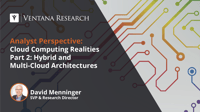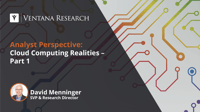In my first perspective on cloud computing realities, I covered some of the cost considerations associated with cloud computing and how the cloud costing model may be different enough from on-premises models that some organizations are taken by surprise. In this perspective. I’d like to focus on realities of hybrid and multi-cloud deployments.
Read More
Topics:
Cloud Computing,
Digital Technology
Organizations are collecting data from multiple data sources and a variety of systems to enrich their analytics and business intelligence (BI). But collecting data is only half of the equation. As the data grows, it becomes challenging to find the right data at the right time. Many organizations can’t take full advantage of their data lakes because they don’t know what data actually exists. Also, there are more regulations and compliance requirements than ever before. It is critical for...
Read More
Topics:
Business Intelligence,
Data Governance,
Data Management,
Data,
data operations,
AI & Machine Learning
Business intelligence has evolved. It now includes a spectrum of analytics, one of the most promising of which has been described as augmented intelligence. Some organizations have used the term to describe the practical reality that artificial intelligence with machine learning is not replacing human intelligence, but augmenting it. The term also represents the application of AI/ML to make business intelligence and analytics tools more powerful and easier to use. It’s this latter usage that I...
Read More
Topics:
Analytics,
Business Intelligence,
natural language processing,
AI & Machine Learning,
Analytics & Data,
Collaborative & Conversational Computing
The migration to cloud is obvious. Organizations are adopting cloud computing for all variety of applications and use cases. Managed cloud services, commonly referred to as software as a service (SaaS), offer many benefits to organizations including significantly reduced labor costs for system administration and maintenance, as many of these costs are shifted to the software vendor. SaaS also provides organizations with faster time to value as they adopt new technologies by eliminating the need...
Read More
Topics:
Cloud Computing,
Digital Technology













